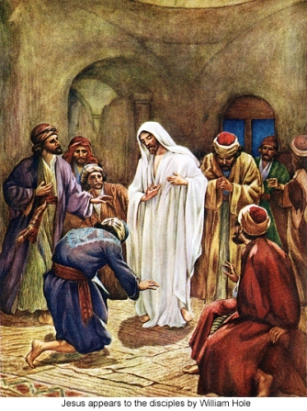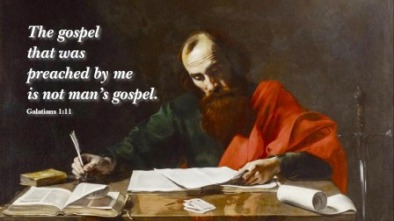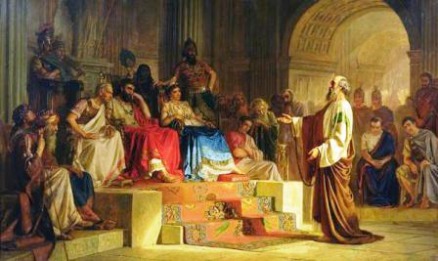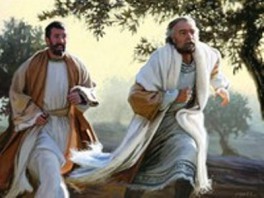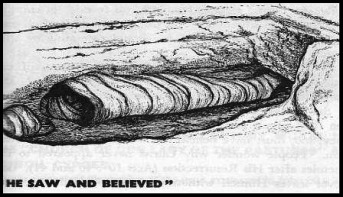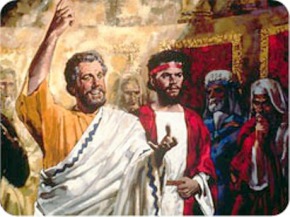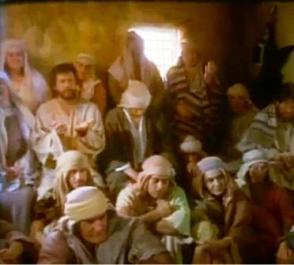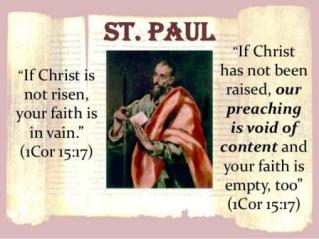Historical Testimonies of First-hand Eye Witness Accounts
When an event takes place in history and there are enough people alive who were eyewitnesses of it or had participated in the event, and when the information is published, one is able to verify the validity of an historical event (circumstantial evidences).[1]
Clark Pinnock also states: "The certainty of the apostles was founded on their experiences in the factual realm. To them Jesus showed Himself alive by many infallible proofs (Acts 1:3). The term Luke uses is tekmerion, which indicates a demonstrable proof. The disciples came to their Easter faith through inescapable empirical evidence available to them, and available to us through their written testimony. It is important for us, in an age that calls for evidence to sustain the christian claim, to answer the call with appropriate historical considerations. For the resurrection stands within the realm of historical factuality, and constitutes excellent motivation for a person to trust Christ as Savior.[2]
Acts 1 (v. 1) The former account I made, Oh Theophilus, of all that Jesus began both to do and teach, (v. 2) until the day in which He was taken up, after He through the Holy Spirit had given commandments to the apostles whom He had chosen, (v. 3) to whom He also presented Himself alive after His suffering by many infallible proofs, being seen by them during forty days and speaking of the things pertaining to the kingdom of God.
The Book of the Acts of the Apostles was written by Luke sometime between A.D. 63 and the fall of Jerusalem in A.D. 70. He explains in the preface to his Gospel that he gathered his information from eye-witnesses, and this it may be concluded, was also the way in which he prepared the Book of the Acts. Further as certain sections in the history show, by the use of the pronoun "we," Luke was himself a participator in some of the events which he narrates. He was in the midst of the early preaching, and took a share in the great happenings of the early days. Luke is therefore, a contemporary and first-hand witness....It is impossible to suppose that the Early Church did not know its own history; and the very fact of the acceptance by the Church of this book is evidence of its accuracy.[3]
Acts 1 (v. 21) Therefore, of these men who have accompanied us all the time that the Lord Jesus went in and out among us, (v. 22) beginning from the baptism of John to that day when He was taken up from us, one of these must become a witness with us of His resurrection.
Professor Kevan says of the epistles of the New Testament,
"....There is the unimpeachable evidence of the contemporary letters of Paul the Apostle. These epistles constitute historical evidence of the highest kind. The letters addressed to the Galatians, the Corinthians, and the Romans, about the authenticity and date of which there is very little dispute, belong to the time of Paul's missionary journeys, and may be dated in the period A.D. 55-58. This brings the evidence of the resurrection of Christ still nearer to the event: the interval is the short span of twenty-five years. Since Paul himself makes it plain that the subject of his letter was the same as that about which he had spoken to them when he was with them, this really brings back the evidence to a still earlier time.[3]
Rom 1 (v. 1) Paul, a bondservant of Jesus Christ, called to be an apostle, separated to the gospel of God (v. 2) which He promised before through His prophets in the Holy Scriptures, (v. 3) concerning His Son Jesus Christ our Lord, who was.... (v. 4) declared to be the Son of God with power according to the Spirit of holiness, by the resurrection from the dead. (v. 5) Through Him we have received grace and apostleship for obedience to the faith among all nations for His name, (v. 6) among whom you also are the called of Jesus Christ;
J.N.D. Anderson, citing Cambridge professor C.F.D. Moule asserts, "From the very first, the conviction that Jesus had been raised from death has been that by which their very existence has stood or fallen. There was no other
motive to account for them, to explain them....At no point within the New Testament is there any evidence that the christians stood for an original philosophy of life or an original ethic. Their sole function is to bear witness to what they claim as an event—the raising of Jesus from among the dead....The one really distinctive thing for which the christians stood was their declaration that Jesus had been raised from the dead according to God's design....[4]
Acts 26 (v. 22) Therefore, having obtained help from God, to this day I stand, witnessing both to small and great, saying no other things than those which the prophets and Moses said would come– (v. 23) that the Christ would suffer, that He would be the first to rise from the dead, and would proclaim light to the Jewish people and to the Gentiles. (v. 26) For the king, before whom I also speak freely, knows these things; for I am convinced that none of these things escapes his attention, since this thing was not done in a corner. (v. 28) Then [king] Agrippa said to Paul, “You almost persuade me to become a Christian.”
John Stott makes the following observations: "It is a remarkable fact that the narratives which say that the body of Jesus had gone also tell us that the graveclothes had not gone. It is John who lays particular emphasis on this fact, for he accompanied Peter on that dramatic early morning race to the tomb. The account he gives of this incident (20:1-10) bears the unmistakable marks of first-hand experience. He outran Peter, but on arrival at the tomb he did not more than look in, until Peter came and entered it. Then the other disciple, who reached the tomb first, also went in, and he saw and believed. The question is: What did he see which made him believe? The story suggests that it was not just the absence of the body, but the presence of the graveclothes and, in particular, their undisturbed condition."[5]
John 20 (v. 3) Peter therefore went out, and the other disciple, and were going to the tomb. (v. 4) So they both ran together, and the other disciple outran Peter and came to the tomb first. (v. 5) And he, stooping down and looking in, saw the linen cloths lying there; yet he did not go in. (v. 6) Then Simon Peter came, following him, and went into the tomb; and he saw the linen cloths lying there, (v. 7) and the handkerchief that had been around His head, not lying with the linen cloths, but folded together in a place by itself. (v. 8) Then the other disciple, who came to the tomb first, went in also; and he saw and believed.
Professor E. H. Day says of John's narrative: "It is characterized throughout by the personal touch, it has all the marks of the evidence not only of an eyewitness, but of a careful observer....The running of the disciples, the order of their arrival at the sepulchre and their entry; the fact that St. John first stooped down and looking through the low doorway saw the linen clothes lying, while St. Peter, more bold, was the first to enter....the description of the position of the linen clothes and the napkin, a description not laboured, but minutely careful in its choice of words; the subsequent entry of St. John , and the belief which followed upon the sight of the grave-clothes....this can surely be nothing else than the description of one who actually saw, upon whose memory the scene is still impressed, to who the sight of the empty grave and the relinquished grave-clothes was a critical point in faith and life."[6]
The following description of the change that occurred in the lives of the apostles after the resurrection is very interesting:
Luke 24 (v. 19) ….And they said to Him, “The things concerning Jesus of Nazareth, who was a Prophet mighty in deed and word before God and all the people, (v. 20) and how the chief priests and our rulers delivered Him to be condemned to death, and crucified Him.” (v. 21) “But we were hoping that it was He who was going to redeem Israel….besides all this, today is the third day since these things happened.”
On the day of the crucifixion they were filled with sadness; on the first day of the week with gladness. At the crucifixion they were hopeless; on the first day of the week their hearts glowed with certainty and hope....What could account for the astonishing change in these men in so short a time?[7]
Acts 5 (v. 25) Then one came and told them, saying, “Look, the men whom you put in prison are standing in the temple and teaching the people!” (v. 27) And when they had brought them, they set them before the council. And the high priest asked them, (v. 29) saying, “Did we not strictly command you not to teach in this name?” (v. 29) Then Peter and the other apostles answered and said: “We ought to obey God rather than men.” (v. 30) The God of our fathers raised up Jesus whom you murdered by hanging on a tree. (v. 31) Him God has exalted to His right hand to be Prince and Savior…. (v. 32) And we are His witnesses to these things….
(v. 33) When they heard this, they were furious…. (v. 40) ….and when they had called for the apostles and beaten them, they commanded that they should not speak in the name of Jesus, and let them go. (v. 41) So they departed from the presence of the council, rejoicing that they were counted worthy to suffer shame for His name. (v. 42) And daily in the temple, and in every house, they did not cease teaching and preaching Jesus as the Christ.
Think of the character of the witnesses, men and women who gave the world the highest ethical teaching it has ever known, and who even on the testimony of their enemies lived it out in their lives. Think of the psychological absurdity of picturing a little band of defeated cowards cowering in an upper room one day and a few days later transformed into a company that no persecution could silence—and then attempting to attribute this dramatic change to nothing more convincing than a miserable fabrication they were trying to foist upon the world. That simply wouldn’t make sense.[7]
Acts 4 (v. 1) Now as they spoke to the people, the priests, the captain of the temple, and the Sadducees came upon them, (v. 2) being greatly disturbed that they taught the people and preached in Jesus the resurrection from the dead. (v. 3) And they laid hands on them, and put them in custody…. (v. 5) And it came to pass, on the next day, that their rulers, elders, and scribes, (v. 6) as well as Annas the high priest…. (v. 7) And when they had set them in the midst, they asked, “By what power or by what name have you done this?”
This is the bold testimony of the men, who were just shortly prior to this scene, a group of cowardly people hiding in the upper room, for fear of the Jews; what a remarkable change!!
John 20 (v. 19) Then, the same day at evening, being the first day of the week, when the doors were shut, where the disciples were assembled, for fear of the Jews, Jesus came and stood in the midst, and said to them, “Peace be with you.” (v. 20) Now when He had said this, He showed them His hands and His side.... (v. 21) Then Jesus said to them....As the Father has sent Me, I also send you.
Now the disciples were coming to a point in their experience when their faith was going to be greatly tested....We know this because when it happened, they fled and completely left Him. In fact, all the disciples were soon hiding behind locked doors in the upper room, and would have remained hidden, and remained unbelievers, had not Jesus pursued them following His resurrection, revealed Himself, reminded them of what was going on, and helped them put all the pieces together.[8]
And what did they have to say, when Jesus sent them out, two by two, into every city?
Acts 2 (v. 22) Men of Israel, hear these words; Jesus of Nazareth, a Man attested by God to you my miracles, wonders, and signs which God did through Him in your midst, as you yourselves also know– (v. 23) Him, being delivered by the….foreknowledge of God, you have taken by lawless hands, have crucified, and put to death; (v. 24) whom God raised up, having loosed the pains of death, because it was not possible that He should be held by it. (v. 36) Therefore let all the house of Israel know assuredly that God has made this Jesus, whom you crucified, both Lord and Christ.
A basic foundation of the establishing of the Church was the preaching of Christ’s resurrection:
In the whole story of Jesus Christ, the most important event is the resurrection. Christian faith depends on this. It is encouraging to know that it is explicitly given by all four evangelists and told also by Paul. The names of those who saw Him after His triumph over death are recorded; and it may be said that the historical evidence for the resurrection is stronger than for any other miracle anywhere narrated; for as Paul said, if Christ is not risen from the dead then is our preaching in vain, and your faith is also vain.[9]
I Cor 15 (v. 13) But if there is no resurrection of the dead, then Christ is not risen. (v. 14) And if Christ is not risen, then our preaching is vain and your faith is also vain. (v. 17) And if Christ is not risen, your faith is futile; you are still in your sins!
We must take this evidence of experts as to the age and authenticity of this writing, just as we take the facts of astronomy on the evidence of astronomers who do not contradict each other. This being so, we can ask ourselves whether it is probable that such book, describing events that occurred about thirty or forty years previously, could have been accepted and cherished if the stories of abnormal events in it were false or mythical. It is impossible, because the memory of all elderly persons regarding events of thirty or forty years before is perfectly clear.[1]
References:
1. Josh McDowell, (1979). Evidence that demands a verdict (vol.1), p.189. Here’s Life Publishers, Inc.
2. J.N.D. Anderson, Wolfhart Pannenberg, Clark Pinnock, (12 Apr 1968). "A Dialogue on Christ's Resurrection." Christianity Today, p.11
3. Ernest Kevan, (1961). The Resurrection of Christ, p.4-6. The Campbell Morgan Memorial Bible Lectureship.
4. J.N.D. Anderson, (1970). Christianity: The witness of History, p.100-101. Tyndale Press.
5. John Stott, (1971). Basic Christianity, p.52. Inter-Varsity Press.
6. Day Hermitage, (1906). On the Evidence for the Resurrection. p.16-17. Society for Promoting Christian Knowledge.
7. J.N.D. Anderson, (29 Mar 1968). “The Resurrection of Jesus Christ.” Christianity Today, p.5-6
8. Dan Augsburger, (2009). The Branch and the Vine (sermons by Frank B. Phillips), p.58, Booklet.
9. Wilbur Smith, (1951). A Great Certainty in This Hour of World Crises, p.18. Van Kampen Press.
Image #1: William Hole, (1906). Jesus appears to the disciples. Retrieved from https://www.catholicireland.net/?homilies=easter-sunday-2
Image #2: Mark Ryman, (2014). The Apostle Paul declares that his gospel was from God. Retrieved from http://carolinasnalc.org/page/112/?amp;m=201406
Image #3: Nikolai Bodarevsky, (1875). Trial of the Apostle Paul, which was uploaded on 2011. Retrieved from https://fineartamerica.com/featured/trial-of-the-apostle-paul-nikolai-k-bodarevski.html
Image #4: Elizabeth Fletcher, (2016). Peter and John run to see the empty tomb. Retrieved from http://www.jesus-story.net/peter_and_john.htm
Image #5: Dan Carr, (2017). The grave clothes: he saw and believed. Retrieved from http://www.biblewalking.com/blog-morning-minute/archives/04-2017
Image #6: Tri-Bible Study, (2014). Peter says: We ought to obey God. Retrieved from http://www.tribiblestudy.com/above.htm
Image #7: Gods hot spot, (2014). Disciples gathering in the upper room. Retrieved from https://godshotspot.wordpress.com/2014/03/11/disciples-in-upper-room/
Image #8: Author unknown, (n.d.). The Apostle Paul preaching in Corinthians. Retrieved from http://slideplayer.es/slide/11830689/
